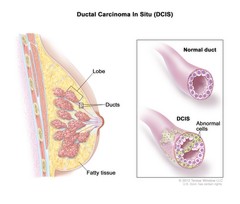Editorial in JAMA Journal Oncology: Rethinking the Standard for Ductal Carcinoma In Situ Treatment
Laura Esserman, MD, MBA1; Christina Yau, PhD1
As demonstrated by Narod and colleagues4 in this large observational study of more than 100 000 women with a diagnosis of DCIS, the risk of dying from breast cancer is low. Less than 1% of patients in this 20-year study died of breast cancer (compared with 5% of patients who died of other causes). Using the Kaplan-Meier method, the breast cancer–specific mortality rate is 3.3% at 20 years, not dissimilar to the statistic that the American Cancer Society5 says is the chance that the average woman will die of breast cancer. This is welcome news and suggests that we can embrace evaluation of alternative strategies to surgery and radiation therapy. CALGB 40903,6 a neoadjuvant study of 6 months of letrozole therapy, is an example of a new approach and should open the door to trials of observation and endocrine risk–reducing therapy. If invasive cancer develops after DCIS, the risk of dying of breast cancer increases substantially. Because the biological characteristics of DCIS often predict the type of cancer that may develop in the future, the value of a DCIS diagnosis may be in providing a clue about how to more specifically prevent a potentially lethal breast cancer.
A second important insight from the article by Narod et al4 is that there are uncommon cases in which DCIS has a higher risk than has been appreciated. When DCIS is diagnosed before the age of 35 or even 40 years, some of these lesions do pose an increased risk of breast cancer–specific mortality. Ductal carcinoma in situ diagnosed before the age of 40 years is likely different because it would present as a symptomatic event (eg, a mass or bloody nipple discharge), as screening prior to the age of 40 years is rare.
Among patients with DCIS, breast cancer–specific mortality is associated with age at diagnosis, ethnicity, and DCIS characteristics such as estrogen receptor status, grade, size (>5 cm), and comedonecrosis. Despite their significance in a multivariable analysis, we note that high-risk characteristics, such as hormone receptor negativity, HER2 positivity, and high grade, often overlap. But only a small minority of patients will have 1 or more of these high-risk characteristics.
For young women (<40 years) who present with symptomatic DCIS — approximately 5% of the population — we should be cognizant that this is a different disease than the typical DCIS. As well, African American women (who have higher risk for hormone receptor–negative breast cancer) and women with hormone receptor–negative or HER2-positive DCIS should continue to be treated according to today’s aggressive standards. In total, these groups probably constitute approximately 20% of the population of patients with DCIS.
The majority of DCIS is detected in women undergoing screening and who are recalled for biopsy of calcifications. To minimize the risk of overdiagnosis and/or overtreatment, it is time to reassess whether clustered amorphous calcifications should be a target for screening, recall, and biopsy, especially in older women.7 Our focus should be instead on lesions (eg, pleomorphic, linear) that more commonly accompany invasive cancer or are associated with hormone receptor–negative or HER2-positive DCIS. Breast imagers should be reassured by the low mortality rate associated with a DCIS diagnosis.
Pages: 1 · 2
More Articles
- *KFF: Gaps in Cost Sharing Protections for COVID-19 Testing and Treatment Could Spark Public Concerns About COVID-19 Vaccine Costs
- A New Study: Sex Differences in Pharmacokinetics Predict Adverse Drug Reactions in Women
- A Johns Hopkins Ethics Nurse Discusses Difficult Decisions, Challenges and Moral Distress: "We know you are overworked, understaffed, possibly heartbroken and anxious, but always courageous"
- Women Firefighters Face High Exposure to Toxic ‘Forever Chemicals’ Known to Interfere with Immune and Endocrine Functions and Breast Development
- Barriers to Health Care Experienced by Women in the United States; Harvard Health on Screening Women Over 75; USPSTF Guidelines for Women Over 50
- Developing an Artificial Intelligence Tool to Help Detect Brain Aneurysms at Stanford
- Oklahoma’s ‘Precedent-Setting’ Suit Puts Opioid Drugmakers On Trial, With a Judge and No Jury
- A Most Unique Statement From FDA Commissioner Scott Gottlieb, M.D., On Efforts to Safeguard Women’s Health From Deceptive Health Claims and Significant Risks Related to Devices Marketed for Use in Medical Procedures for “Vaginal Rejuvenation"
- First Scientific Study to Test the Premise of Facial Exercise Improving Appearance
- Congress: A Number of Measures for Women Veterans, Child Protection, Protecting Young Victims from Sexual Abuse Act, Federal Interns Protection Act, Opioid Epidemic







